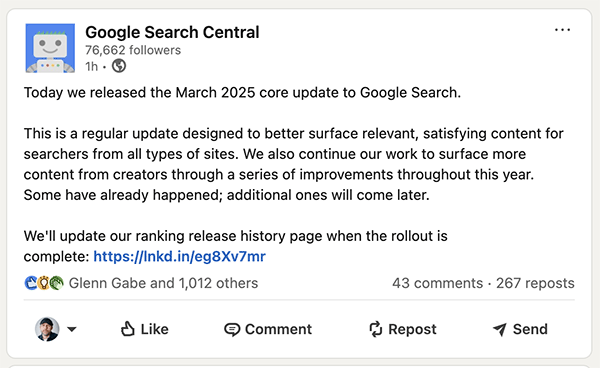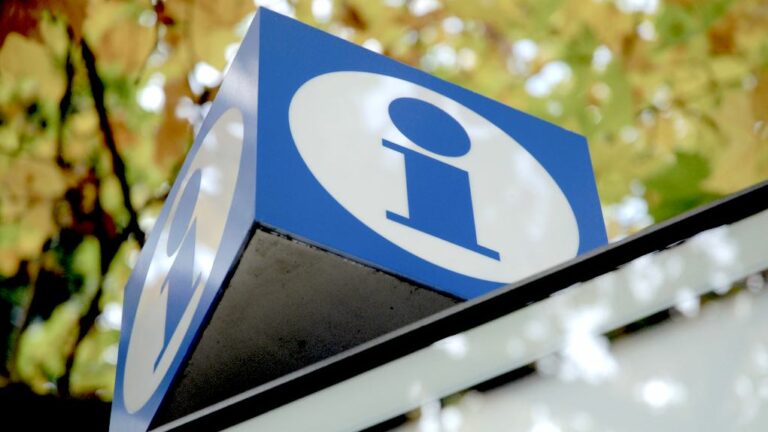
In this post I explain the steps you can take to recover from a dip in traffic to your website caused by a Google Core update.
Google core updates can have massive implications for businesses that rely heavily on organic traffic; Google, after all, currently handles over 90% of the web’s search queries (source: Statcounter).

Some organizations experience huge drops in their website traffic as a result of a core update, and this obviously has very negative implications for the profitability — or even viability — of many businesses. In many cases, a Google core update can be worse for a business than a recession.
But there is good news: there are steps you can take to gradually improve the situation and give your site the best chance possible of regaining lost rankings.
And, in this post, I’m going to give you a checklist of these steps.
But before working your way through this recovery checklist, it’s important to be very clear about what a Google core update actually is.
So, let’s start with that.
What is a Google core update?

Google’s search algorithms are updated all the time — pretty much every day, in fact, according to Google.
However, sometimes, Google makes big changes to them, and these are called ‘core updates.’
The most recent of these updates – the appropriately-named ‘March 2025 core update‘ – was released on 13 March 2025.

Now, the starting point to recovering from a core update is to take a close look at how Google explains them.
And the company’s official definition of what core updates are is as follows:
Several times a year, we make significant, broad changes to our search algorithms and systems. We refer to these as core updates…
They’re designed to ensure that overall, we’re delivering on our mission to present helpful and reliable content to searchers.
Source: Google Search Central Blog
Although on first inspection this statement sounds a bit vague, if you look at it closely you’ll see that it contains two pretty big hints about why a site may have been demoted in Google’s index: it was perceived by Google to have problems with its helpfulness and reliability.
The question is: can you actually fix these problems?
And if so, how?
Let’s find out what Google has to say about this.
Google’s official take on recovering from a core update
Over the years, Google has given mixed messages about how possible it is to recover from a core algorithm update, and how desirable it is to even try.
For a long time, the company’s support materials about core updates stated fairly explicitly that “pages that drop after a core update don’t have anything wrong to fix.”
This advice became a bit more ambiguous in May 2022:
We know those with sites that experience drops will be looking for a fix, and we want to ensure they don’t try to fix the wrong things.
Source: Google advice on the May 2022 core update
And in March 2024, the advice became more specific again:
For those that might not be ranking as well, we strongly encourage reading our creating helpful, reliable, people-first content help page.
Source: Google advice on the March 2024 core update
The implication of these last two statements is that there ARE fixes that can be made.
And John Mueller, a Search Advocate at Google — a key public face of the company when it comes to advising site owners on SEO — has indicated a few times that it is, in fact, possible to make changes to your site that can bring lost traffic back after a core update.
The video call below contains a particularly clear statement from him on this — in the opening few minutes, where Search Engine Land’s Barry Schwartz discusses the issue of recovery with him.
But what are these improvements that can potentially get you out of a traffic dip?
Well, there is no definitive answer to this — because Google keeps the vast majority of the inner workings of its algorithms secret.
However, based on…
- the research we’ve carried out
- our experience of dealing with algorithm updates
- the advice Google has to offer on creating quality content
we’ve identified steps that – over time – can help. I’m going to walk you through these now.
The first thing to do is…stay calm.
1. Don’t panic

When faced with a large dip or even an outright collapse in your site traffic, freaking out is a totally understandable reaction.
However, it can also be counterproductive if it leads to you rushing through a bunch of changes to your site and its content without fully thinking them through.
A key thing to remember about Google updates is that they usually take a few weeks to roll out.
During Google updates, search results are often filled with a lot of wild, but temporary, changes in rankings. This is something that SEO experts sometimes refer to as the ‘Google Dance.’
And, if you’re lucky, you may find that your traffic has actually reverted back to its original level within a couple of weeks (or, in some cases, even increased).
So, making huge, radical changes to your site in the middle of a core update can be a huge gamble — and one that could negatively affect aspects of your content that Google actually approves of.
So, stay calm, and wait until you know that a core update rollout is complete and that you have definitely been adversely affected before taking action on your site.
Tip: You can find out when a core update is finished rolling out via updates from Google’s official list of algorithm updates.
The Search Engine Roundtable and Search Engine Land websites are good places to check for details on how a Google core update is progressing, or to get news about post-update trends in rankings that have been identified by the SEO community.
2. Use data to identify content that needs improvement

Once the rollout of a core update is complete, it’s time to identify the content that has been particularly badly affected by it.
If you use an SEO tool like Ahrefs or Semrush, you may already have rank tracking in place; this can help you spot rankings that have taken a particularly bad hit.
Google’s Search Console and Google Analytics can also help you identify pages that have suffered significant traffic drops. You should be able to spot these by looking at the number of visits to them before the announcement of a core update and in the days after it.
Using the data from these tools, compile a spreadsheet of ‘problem pages’ that have seen a particularly sharp drop in traffic.
Then…
3. Improve the helpfulness of your problem pages

Remember that statement from Google outlining the main purpose of core updates?
“They’re designed to ensure that overall, we’re delivering on our mission to present helpful and reliable content to searchers.“
As discussed, this basically spells out why the content in the list of ‘problem pages’ you’ve just compiled has been pushed down the search rankings: it’s now viewed as being less helpful and reliable than that of your competitors.
Let’s tackle the helpfulness aspect first. How can you make your content more helpful than everybody else’s?
Ensure your pages and posts are up to date
Google has been quite clear about the fact that it uses content ‘freshness’ as a way to determine helpfulness and relevancy.
In fact, as long ago as 2010 it publicly announced that it had created an algorithm specifically to do that: ‘Caffeine.’
It’s easy to confuse ‘freshness’ with ‘I must produce new content,’ however. While publishing new posts periodically is important, it’s not going to solve your immediate problem here: the fact that your existing pages and posts are now receiving less traffic.
So, look at your existing ‘problem pages’ and correct any out-of-date or inaccurate information they contain.
(This is particularly significant if you run a reviews site — products and services can change over time and in order for your reviews to stay helpful to users, they will need to reflect these changes.)
It’s important to note however that making extremely minor changes to pages and then republishing them with a more recent date is unlikely to impress Google (in fact it is likely to do the opposite).
Realistically, only substantial and genuinely helpful changes are likely to be rewarded.
Ensure you are covering topics in the right level of detail
One of the biggest clues you can get about what Google considers helpful content is publicly available — in the form of its top search results.
Now, it has to be said that ‘helpful’ is a hugely subjective word — and some of the stuff that Google has been putting at the top of search results recently (spammy Reddit threads, or reviews of products written by the manufacturers of those products!) has been anything but useful to users.
Nonetheless, looking at the pages and posts that are now outranking yours can give you some insights about the tricks you might be covering.
When doing this, ask yourself some questions:
- Do they mention an aspect of a topic that you forgot to?
- Do they go into more detail on a particular issue than you?
- Do they share unique insights on a situation that are not to be found anywhere else?
If the answer to any of these questions is ‘yes,’ it may be time to rewrite your content — and to do so in a more comprehensive way.
However, readers often want digestible information as much as a deep dive, so think about ways that you can cater both for readers who want a quick answer, and those that want to learn about a topic in depth.
(Sometimes summaries or ‘quick answer’ boxes at the top of a page can help square this circle a bit.)
Ensure your content is written with humans, not search engines, in mind
Many content creators end up obsessing about ‘ranking signals’ — some real, some imagined – and end up producing stuff that they think a computer program will like.
But it’s vital to remember that at the end of the day, both you — and search engines, in their choice of what to surface in results — are aiming to present content that is helpful to humans.
Google has been stressing the need to focus your content creation efforts on ‘real’ people rather than search engines for some time now, but with the rise of generative AI, and the ability it gives website owners to create ‘thin’ content at scale, is placing an ever greater emphasis on ranking content that is genuinely helpful.
Accordingly, ensure that you place helpfulness and a positive user experience at the heart of any content you’re trying to improve.
So, make sure that your content is always:
- well-researched and factually accurate (with sources quoted).
- 100% relevant to the topic it claims to address.
- easy to read and navigate.
Tip: try user testing
As part of the process of improving your content, consider carrying out some user testing.
You can do this by encouraging members of the target audience for your content to read and feed back on your existing content and any revised versions of it.
This can help you identify areas that need work, or validate improvements.
Sense-check your poorly-performing pages against Google’s helpfulness questions
Google has a list of questions that it encourages you to ask yourself when trying to improve content that has been affected by a core update.
The ones that focus on improving content quality and helpfulness are as follows:
- Does the content provide original information, reporting, research, or analysis?
- Does the content provide a substantial, complete, or comprehensive description of the topic?
- Does the content provide insightful analysis or interesting information that is beyond the obvious?
- If the content draws on other sources, does it avoid simply copying or rewriting those sources, and instead provide substantial additional value and originality?
- Does the main heading or page title provide a descriptive, helpful summary of the content?
- Does the main heading or page title avoid exaggerating or being shocking in nature?
- Is this the sort of page you’d want to bookmark, share with a friend, or recommend?
- Would you expect to see this content in or referenced by a printed magazine, encyclopedia, or book?
- Does the content provide substantial value when compared to other pages in search results?
- Does the content have any spelling or stylistic issues?
- Is the content produced well, or does it appear sloppy or hastily produced?
- Is the content mass-produced by or outsourced to a large number of creators, or spread across a large network of sites, so that individual pages or sites don’t get as much attention or care?
Source: Google’s guide to creating helpful, reliable, people-first content
Answer all these questions (honestly!) and improve your content based on your answers.
4. Improve your pages from a reliability point of view

Whether or not Google views your content as reliable essentially boils down to how much it can trust it: there are a variety of things it looks for to establish whether or not you are a credible source of information.
And there are two ways you can prove your credibility: by engendering ‘on-page’ and ‘off-page’ trust.
Improving on-page trust
Google is (unusually) open about what constitutes trustworthy content: its Search Quality Evaluator Guidelines document outlines — in considerable depth — the characteristics that are associated with a piece of reliable, authoritative content.
This document contains a series of ‘Experience, Expertise, Authoritativeness and Trustworthiness‘ (or ‘E-E-A-T’) benchmarks that can be used to determine whether a page should be considered an authoritative source of information on a particular subject.
It’s worth reading the document in full to get a complete picture of these benchmarks, but some key takeaways for improving the trustworthiness of a page or post are as follows:
- Ensure that your content is hosted on a secure website (i.e., a ‘https’ one).
- Ensure that it is clear who the author of a piece of content is, and that a clear link to an author biography (one that outlines their credentials and experience) is available on the page or post.
- Ensure that the main content on the page is in-depth, factually accurate, grammatically correct and easy to understand.
- If possible, ensure your content is created by established writers / journalists who have a good reputation in their niche.
- When you make a claim, back it up with a reference (and ideally a hyperlink) to an authoritative source.
- Conduct your own research into a topic where possible, and cite it.
- Provide an ‘About’ page and clear contact details (phone numbers, addresses, contact forms) on your site.
- Clearly reference and display any relevant awards, credentials or qualifications associated with your work / business.
In addition to the Search Quality Evaluator Guidelines document referred to above, Google has published a set of questions to help you determine if there are any quality issues with a piece of content. These are definitely worth reading — and again, answering honestly.
“We suggest focusing on ensuring you’re offering the best content you can. That’s what our algorithms seek to reward.”
Source: Google Search Central
Improving off-page trust
Once you’ve done everything you can to improve the on-page credibility for a piece of content that has suffered as a result of a core update, it’s time to look at what you can do for it ‘off page.’
This is because Google doesn’t trust pages based solely on the content of the page itself — it looks at how much other pages trust it too.
Gaining trust through links
The most obvious example of ‘off page’ trust is generated by links — it’s no secret that if a lot of high-quality pages link to your content, it stands a much better chance of performing well in search engine results pages.
However, it’s worth pointing out here that Google’s John Mueller is on record as saying that core updates are more about the quality and authority of content, rather than how good your backlink profile is:
“In general, with the core updates, if you’re seeing changes there, usually that’s more related to trying to figure out what the relevance of a site is overall and less related to things like spammy links.
John Mueller, Google Hangout, July 2021
So I wouldn’t necessarily assume that getting rid of a bunch of poor-quality links will solve core update problems.
But that said, if you have a large number of questionable links pointing to your site — ones that you know you have paid for, or ones that are the result of shady link schemes — then there is an argument for trying to get rid of them.
(Other poor-quality links can generally be ignored — the dangerous ones are usually those you’ve paid for or attained through means that go against Google’s policies on backlink building. According to various statements by Google’s John Mueller, disavowals should be reserved for links that you know you bought.)
While a link clean-up in itself is highly unlikely to reverse a rankings drop related to a core update, it nonetheless may help you gain some traffic and mitigate its effect.
Similarly, some outreach to high-quality websites that generates some valuable links may have a similarly positive ‘offsetting’ effect.
So, if you’ve noticed a dip in traffic to a particular page, look at its backlink profile in some depth, to ensure that:
- there are links to it from authoritative websites
- there are no highly unnatural links pointing to it.
If you find that the link profile of a particular piece of content is rather thin, it might be time to consider some (strictly ‘white-hat’) link building outreach and online PR to boost it.
If you find a lot of unnatural links pointing to one of your ‘problem pages’, try to get them removed, or consider disavowing them using Google’s disavow tool.
Proceed with caution with the second tactic however, as if carried out incorrectly, this can really hurt your SEO — and some Google staffers are on record as saying that in most cases, disavowing isn’t really necessary.
Building trust via brand mentions
Another way that you can can help Google view your content as being trustworthy is by seeking out mentions of your brand on other sites.
Google has been quite clear that this can help with rankings, with Google Webmaster Trends Analyst Gary Illyes saying:
If you publish high-quality content that is highly cited on the internet — and I’m not talking about just links, but also mentions on social networks and people talking about your branding…then you are doing great.
Gary Illyes (Keynote speech, Brighton SEO)
And studies show that recent Google algorithm updates (which now integrate its ‘helpful content system’) may have actively reduced traffic to sites that don’t have much of a branded presence (or people searching for their brand.)
Key related resource: Overcoming Google’s Helpful Content Update: Is Branded Search the Answer?
You can increase brand mentions by:
- getting interviewed in relevant publications / podcasts
- growing a social media following and posting more content to it
- encouraging social shares (this can be done by adding sharing call to actions in your content, tools to help readers share etc.)
- contributing to forums, adding comments to blog posts etc.
- speaking at conferences — this may lead to people mentioning your brand on social media, blog posts etc.
- sponsoring events — this can lead to your brand being featured in various online publications (and can lead to some nice backlinks too).
(You could also consider guest posting — but I’d focus on doing so on high-quality blogs only. Google is not always a fan of guest posting, especially when the aim is mainly to get a backlink out of it).
As with any SEO tactic, it’s important not to overdo things with brand mentions — be selective about where you seek out them out. Always focus on quality over quantity, and avoid any spammy tactics.
5. Conduct competitor analysis

If one of your pages goes down in search rankings and a competitor’s goes up, this isn’t because of magic — it’s because your competitor is doing something better than you (at least in Google’s eyes!).
The good news is that there are now lots of SEO tools available to help you find out what that ‘better thing’ is.
For example, using apps like Semrush, you can find out:
- what keywords are more present in a competitor’s copy than yours
- who is linking to that piece of content
- who is mentioning that brand.
All this information can help you recraft your content from a relevance point of view, or find out who the right people to approach for links and brand mentions are.
However, it’s important not to rely solely on software to work out what’s going wrong with your content — as mentioned earlier, Google wants to reward content that humans like.
So, always make a close personal inspection of the pages and posts that are now outranking yours, to see if they are easier to read and use; nicer to look at; or more shareable.
Then, use this research and any insights gained to improve your own content.
While you’re here, download our free SEO toolkit
For a limited time only we’re offering our readers some excellent free SEO tools and resources. Sign up and receive:
- our downloadable cheatsheet containing 20 key steps to ranking highly in search results
- extended free trials and discounts for leading SEO tools
- our downloadable cheatsheet on how to grow organic traffic to a blog
- 2 in-depth guides to SEO
- ongoing free tips and advice on SEO and growing your business
6. Revisit your technical SEO basics

As I’ve discussed a number of times throughout this post — and as Google has repeatedly said — core updates chiefly deal with aspects of content that make it more helpful and reliable.
Now, this might lead you to think that recovering from a Google core update isn’t really going to involve sorting out technical SEO issues like mobile usability, page speed, core web vitals and so on.
And, in general, you’re probably right.
However, the thing to remember about technical SEO is that a good technical setup helps generate a positive user experience — which can in turn make a page more helpful and reliable.
Let’s say that a user reads two articles about web design:
- one that loads slowly, doesn’t appear correctly on a mobile device and is packed with ads that make the content jump, and scrolling difficult; and
- one that loads super quick on a mobile device and doesn’t contain any intrusive ads or popups.
Which one do you think the user — and Google — will trust more?
Which one is more likely to get shared or linked to?
It doesn’t take a rocket scientist to work out that it’s the second one.
So, as part of any core update recovery process, it makes sense to address key technical SEO issues that are negatively affecting your user experience.
Consider making improvements to:
- page loading times
- Core Web Vitals scores
- headings, page titles and meta descriptions
- navigation structure
- internal and external links (make sure there are no broken ones or redirect chains)
- SSL
- XML sitemaps
- robots.txt files
- structured markup
Even if these improvements don’t make a very direct impact on relevance and authority, they still have the potential to help you improve traffic levels in general — something that can, at the very least, offset a dip in organic traffic caused by a core update.
7. Offset your traffic loss by publishing new content

So far, we’ve discussed what you can do to your existing content to help you recover from a Google algorithm change.
However, there is also the option to publish new content on your website as a way to get more search traffic.
By publishing more pages and posts on your site, you are going to be giving Google more opportunities to index content and present it to users; you are also giving users more content that they can link to or share. All of this can help generate new organic traffic that can make up for the hits you’ve lost.
You could consider using new content as a way of establishing ‘topical authority‘ for your site — as the name of this SEO tactic suggests, this involves covering all aspects of a particular topic in considerable depth, thus sending a signal to Google that you are an expert on that topic.
(Keyword research is important here: you’ll need to put some effort into finding out what people are actually searching for in your niche and identifying the sort of phrases you can realistically rank for — and create content based on this data. Tools like Moz or Ahrefs can help with this process.)
The key thing here however is to put quality at the heart of your new pages and posts; to ensure that any new content contains the helpfulness and reliability signals that I’ve discussed throughout this article.
And I’d definitely view this step as a ‘phase B’ tactic — it’s best to sort out any problems with existing content before publishing a lot of new stuff!
Wrapping up / cheatsheet
I hope you’ve found this guide to recovering from a Google core update helpful! Below you’ll find a cheatsheet containing the key steps I’ve discussed throughout this article.
Good luck with improving your rankings, and if you have any questions, do leave them in the comments section below — we read them all and will do our best to answer any queries you may have.
Finally, please do share this content if you think it would be helpful to others.
Cheatsheet: recovering from a Google core update
- Stay calm.
Wait until a core update has fully rolled out before making any radical changes to your content or website. Sometimes rankings that have been lost in the immediate aftermath of a core update release can return during its rollout. - Remember Google’s key reasons for demoting your content: it’s less helpful and reliable than it could be.
Google has made it clear that the reason pages lose rankings is because they are no longer as helpful or reliable as they once were. So make sure that you place increasing helpfulness and trustworthiness at the heart of any changes you make to your content. - Use data to identify the content that needs improvement.
Use tools like Google Analytics, Google Search Console, Ahrefs and Semrush to identify the pages that have lost rankings. Make a list of these ‘problem pages’ that you can refer to throughout the improvement process. - Recraft your content from a helpfulness point of view.
Recraft your problem pages so that they are as helpful to users as possible. Ensure they are fully up to date, tackle topics in the right level of depth and are designed to appeal not just to search engines but human readers too. - Improve the authority of your problem pages by building authoritative links to them and gaining brand mentions.
Google will trust your content more if it sees authoritative links to it along with mentions of your brand online. Build quality links to your problem pages via outreach and online PR, and seek out increased mentions via guest blogging and social shares. Consider removing or disavowing highly spammy links to your problem pages (but tread very cautiously here, as link removal can hurt SEO as well as help it — only disavow links if you are very sure that you have bought them, or have a manual penalty to deal with). - Perform in-depth competitor analysis.
Take a in-depth look at the pages and posts that are now outranking yours. Find out what your competitors are doing from a content quality and backlink building point of view — and see if you can do both better. - Make technical SEO improvements.
Peform a technical SEO audit on your content and ensure that everything is set up as well as possible on that front. Doing so can dramatically improve a user’s experience, which can in turn make your content more helpful and reliable. - Consider publishing new content
Publishing new content that gets indexed and ranked by Google can be a way to offset a loss in traffic caused by a core update. It’s also a way to build more topical authority on a subject. However, this tactic is only likely to work if the content produced is of a very high quality and adheres to Google’s expectations on helpfulness.
How to recover from a Google core update — FAQ
What is a core update?
A core update is a significant, broad change to Google’s search algorithms and systems. It typically focuses on the relevance and authoritativeness of website content, rewarding pages and posts that display both with higher search results, and demoting those that don’t.
When was the most recent core update?
The most recent Google core algorithm update took place in March 2025. You can see a full list of publicly announced core updates (along with other types of Google algorithm updates) on Google’s list of search ranking updates.
How do I recover from a core update?
Recovering from a core update typically involves researching what the sites now outranking yours are doing better than you; making significant improvements to the quality of your content from a relevance and authority point of view; seeking out higher quality links and brand mentions; and publishing more content.
How do I know when a Google core update has started?
Google announces all its updates on its list of search ranking updates.
How do I know when a core update has finished rolling out?
Google lets site owners know when a particular update has finished rolling out on its list of search ranking updates.
How long does recovery from a core update take?
Google has indicated that making positive changes to your content can result in gradual improvements to your rankings over time. However, generally you will have to wait until the next core update rolls out to see the full effects of any improvements you have made.
Comments (9)
The same happened with me. I was receiving 150+ visitors every day over the last 3-4 years, and after the March core update I have lost both my traffic and rankings. I haven’t made any changes to my existing content.
Google is doing whatever it can to destroy small publishers. The mere fact that backlinks still remain an authority ranking value is laughable. So many junk backlinks services are thriving. The core update is google kiss of death. I spent so many years and work to create quality content, and I was considering retiring, I saw Chatgpt as a threat, but Google is my biggest enemy.
I have very weird situation here.
I started my website on 19 July 2023. Till 22 August there were 70-80 impressions everyday. And from 23rd of August when a core update started there was a dramatic boost on my website — I got 1000 clicks in just 28 days. Some of my pages came in first position beating many high DA websites. But today, on 11 September 2023, I saw 0 users on my website.
Experts please explain this situation!
This update really hit me hard. Thanks for your article — I will follow the step by step guide in this post.
Our website traffic dropped drastically since 20th Jan. We haven’t made any changes to content, or any technical updates. GSC don’t show anything specifically wrong. What could be the reason? How do we troubleshoot?
Hey Rajana, thanks for your comment and sorry to hear about your loss of traffic. It’s hard for me to give specific advice here (as I’m not familiar with your website) — but there are a few checks worth making that may help you spot problems.
First, check if there’s actually been any Google updates (whether announced officially or not) that may be to blame. Search Engine Roundtable is a good place to find out if there have been any recent ones. If there hasn’t been any sign of an update, the traffic drop is probably due to something else.
If you suspect the traffic drop is *not* due to a Google update, then…
– check that your Google Analytics tags (or those relating to other analytics tools) are installed correctly and not underreporting traffic.
– check that Google hasn’t applied a ‘manual action’ to your site for violating any of its policies (look at the manual actions report in Google Search Console to see if it has).
– check that nobody’s edited your robots.txt file in a way that could prevent Google from crawling your site properly.
– check that your site is working well from a general technical point of view (test it using a variety of browsers / devices / networks).
– check that there’s nothing seasonal (festivals, holidays etc.) that could be affecting traffic levels. For example, as I post this comment, a lot of people are celebrating Chinese New Year. That may have something to do with it.
Hope the above helps and good luck with recovering your traffic.
The problem with this is that Google has pushed thin content that doesn’t go into as much detail as mine to the top of google and knocked me off the top….
Same here ????
Thanks for your comments both. I guess what I’d say is that it’s not just about detail, it’s about relevance. Shorter content that answers a query better and faster than a piece of long-form content will trump the latter.
Authority counts too of course — that’s where the links and brand mentions come in.
Either way I hope your content recovers quickly — Google core updates can be extremely tough on site owners.